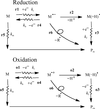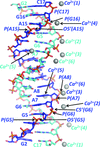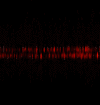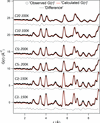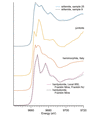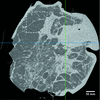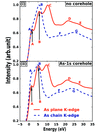issue contents
July 2019 issue
Includes papers presented at the 10th International Workshop on X-ray Radiation Damage to Biological Crystalline Samples
Brookhaven National Laboratory, Upton, NY, USA, 13–14 September 2018

Cover illustration: Group photograph of the attendees at the 10th International Workshop on X-ray Radiation Damage to Biological Samples (courtesy Brookhaven National Laboratory). This issue of Journal of Synchrotron Radiation contains nine papers covering various aspects of radiation damage in macromolecular crystallography and small-angle X-ray scattering experiments. Much of the research reported in them was presented and/or discussed at the workshop. An introduction to the special issue papers is given by Garman & Weik, pages 907–911.
facility information
radiation damage
Free 

With the continuing development of beamlines for macromolecular crystallography over the last few years providing ever higher X-ray flux densities, it has become even more important to be aware of the effects of radiation damage on the resulting structures. Nine papers in this issue cover a range of aspects related to the physics and chemistry of the manifestations of this damage, as observed in both macromolecular crystallography and small-angle X-ray scattering on crystals, solutions and tissue samples.
Open  access
access
 access
accessThe effect of utilizing high-energy X-rays for macromolecular crystallography of a radiation-sensitive metal enzyme was investigated. The resultant structure was evaluated in combination with visible absorption spectroscopic data. No explicit energy dependence of radiation damage was found in the range from 10 to 30 keV.
PDB reference: bovine heart cytochrome c oxidase, 6j8m
The potential for using higher X-ray energies in macromolecular crystallography is explored, with an analysis of the diffraction efficiency as a function of crystal size and beam energy. Calculations, which for the first time include the detector response, show an improvement in diffraction efficiency for microcrystals by increasing the incident beam energy, with a `sweet spot' at 26 keV.
A study on a metallo-enzyme shows a linear impact on global damage metrics with dose and specific changes in active-site residues. Metal motion occurred, but was driven by unit-cell expansion and not by direct radiation chemistry effects on the metal site.
What are the radiation-induced intermediates and expected end products that cause the structural degradation of X-ray crystallographic data?
Site-specific X-ray triggered photo-oxidation combined with temperature-controlled crystallography can provide a powerful means to reveal structural mechanisms of macromolecular function for cysteine-dependent enzymes.
Structural studies in solution on the low-dose radiation exposure of transforming growth factor beta-1 (TGFβ-1) in complex with latency-associated peptide suggest that the X-ray radiation studied is not sufficient to completely drive TGFβ-1 dissociation and activation, and that a previously recognized damage pathway manifests as protein aggregation. The study demonstrates that knowledge developed to understand and mitigate radiation damage can give an understanding of systems at therapeutic doses.
Highly dose-demanding experiments on soft tissue using microfocused or nanofocused X-ray beams require a careful assessment of the tolerable dose. Experimental evidence for detrimental dose effects can be supplemented by Monte Carlo simulations that can give additional guidance to the experimenter for a maximally dose-efficient planning of future experiments.
Open  access
access
 access
accessX-ray-induced heating of microcrystals is quantified through the temperature-dependent shift in X-ray-induced fluorescence from ruby crystals.
A radiation-damage study of a DNA 16-mer crystal at 100 K is reported, identifying sites of specific damage and concluding that the DNA exhibits slightly lower radiation sensitivity to both global and specific damage than do most proteins.
research papers
Commissioning of a photoelectron spectrometer for soft X-ray photon diagnostics at the European XFEL
Commissioning and first operation of an angle-resolved photoelectron spectrometer for non-invasive shot-to-shot diagnostics for photon energy and polarization at the European XFEL soft X-ray beamline SASE3 are described.
The xcalib toolkit has been developed to calibrate the spatial fluence distribution at the focal spot of an intense X-ray free-electron laser beam. The method is based on an automated optimization procedure that compares experimental charge state distributions with first-principles calculations.
Soft X-ray photon-in/photon-out spectroscopy experiments on the PAL-XFEL are discussed.
The K-monochromator system at the European XFEL was designed for commissioning and adjustment of the SASE undulators. Methods for undulator measurements, and first results for gap and vertical offset measurements are described.
Installation, commissioning and operation of X-ray gas monitors at the European XFEL are described. These monitors measure non-invasively single-shot pulse energies and average beam positions.
Open  access
access
 access
accessPresented here is a compact hard X-ray split-and-delay line for studying ultrafast dynamics at free-electron laser sources. The device is capable of splitting a single X-ray pulse into two fractions with delay times from −5 to 815 ps and femtosecond resolution, operating continuously in a wide energy range between 7 and 16 keV.
Open  access
access
 access
accessAn original and novel design scheme has been formulated to achieve an extremely high resolving power for a broad-band X-ray spectrometer with a relatively large source size, implementing a meridional pre-convex mirror to enhance the resolving power substantially while maintaining minimal intrinsic optical aberrations for the whole system to cast a decent flat-field at the detector domain throughout the spectral range.
Diffraction properties of strongly bent defect-free diamond crystals have been measured and compared with the modelling based on the Takagi–Taupin equations.
Open  access
access
 access
accessAn overview is given of the SwissFEL soft X-ray free-electron laser (FEL) beamline, called Athos, and its numerous operation modes. In particular, several key hardware components are described, which enable these modes. The main FEL parameters and expected performance figures are also reported.
A simple scheme to enhance the coherence of self-amplified spontaneous-emission (SASE) free-electron lasers (FELs) in a more compact undulator beamline is presented. The method only requires small chicanes that can be easily installed between the undulator modules of the FEL facility. Numerical simulations show that, with respect to the standard SASE case, the spectral bandwidth can be improved by up to a factor of ten and the saturation length can be reduced by at least 20%.
Open  access
access
 access
accessCharacterization of the absolute photon pulse energy and beam position of free-electron lasers (FELs) is essential for many user experiments, as well as for machine operators. Described here is an X-ray gas monitor which is a suitable tool for FEL photon diagnostics over a broad spectral range from vacuum ultraviolet to hard X-rays.
Hard X-ray self-seeding based on a diamond wake monochromator has been commissioned at PAL-XFEL using various bunch charges and crystals. The performances of self-seeding and low electron-energy jitter (∼10−4) are discussed.
Open  access
access
 access
accessThe European XFEL requires long and ultraflat X-ray mirrors of high precision for the beam offset and distribution system in each beamline; it is foreseen to have at least one mirror with bending capabilities. Here, the calibration procedure before and after installation is described, with a focus on the differences, possible explanations and improvements.
Open  access
access
 access
accessHere a direct comparison is made between various X-ray wavefront sensing methods with application to optics alignment and focus characterization at X-ray free-electron lasers. Difference wavefront measurements with and without a corrective phase plate agreed with its design to within λ/20, enabling a direct quantitative comparison between methods.
PAL-XFEL facilitating the 3-BC scheme has achieved reliable XFEL operation with unprecedented stability. Its outperformance over the 2-BC scheme is discussed.
Open  access
access
 access
accessPolarization control using an X-ray phase retarder in combination with an arrival timing diagnostic on BL3 of SACLA is reported.
Details of design, construction and implementation of the first in situ STED microscope, which has been installed on the optical table of a synchrotron endstation instrument, are presented.
A carbon-contaminated synchrotron mirror has been cleaned by an RF plasma cleaning technique. The cleaned mirror was characterized by Raman spectroscopy, soft X-ray reflectivity and atomic force microscopy measurements.
Open  access
access
 access
accessA novel high quality, high numerical aperture custom-made macroscope optics makes 10–20 Hz high-resolution tomographic studies at TOMCAT routine. The macroscope performance was characterized and found to be superior compared with previous high-spatial- and high-temporal-resolution setups available in-house: the new macroscope is 4 to 8 times more efficient and the spatial resolution is improved by up to a factor of 6.
Open  access
access
 access
accessUsing an X-ray waveguide, the focal spot size and coherence properties of the NanoMAX Kirkpatrick–Baez mirror system have been measured.
A simple analytical equation is presented that predicts the diffraction efficiency for a blazed grating in good agreement with more rigorous calculations. As the reflectivity and the geometrical factors separate, this allows the grating performance to be optimized, starting rather generally without considering explicitly the blaze angle.
A variable Cff optimization method is introduced for a variable-included-angle varied-line-spacing plane-grating monochromator. By adopting this method, the Cff value can be arbitrarily selected in the monochromator.
Open  access
access
 access
accessMutual optical intensity propagation through synchrotron beamlines is established by including the in-plane wavevector distribution.
A new ultra-compact transfocator for X-ray focusing and microscopy is presented. The device can be used to change the number of one- and two-dimensional focusing compound refractive lenses by moving the individual parabolic X-ray refractive lenses one-by-one independently, thus providing permanent energy and focal length tunability for a wide range of applications.
Open  access
access
 access
accessAn electron beam position and angle monitoring system, ps-BPM, has been shown to be able to measure the electron source position and angle at a single location in a beamline at a synchrotron source. This system is now shown to be capable of measuring the source size and divergence simultaneously.
Results are reported of experiments carried out to demonstrate the magnetic performance of monocrystalline dysprosium (Dy) to enhance the capability of undulators.
Low-gain avalanche detectors have been characterized using X-rays. Preliminary tests show promising results towards the development of soft X-ray single-photon-counting detectors.
The design, construction and commissioning of a cost-effective spinning capillary cell is reported for in situ powder X-ray diffraction for pressures up to several hundred bar. In situ recorded data have been quantitatively analyzed by the Rietveld method.
The quality of EXAFS measurements at extreme pressure in the diamond anvil cell is hampered by experimental constraints such as sample and X-ray geometries, but most notably the effects of non-hydrostatic stress arising from the uniaxial nature of the cell itself, especially across first-order transitions to high-pressure phases. By employing a CO2 laser (10.6 µm) illumination to directly heat samples of a ceramic material (SnO2), it is possible to generate high-quality EXAFS data annealed purely into a high-pressure phase, and perform rigorous disorder analysis made possible only by the stress-relieved state made possible by the technique.
A benchmark experiment that demonstrates the shortening of hard X-ray pulses in a synchrotron-based optical pump–X-ray probe measurement is reported.
Polycrystalline Zn-phthalocyanine layers thermally deposited on Si substrates at different temperatures under vacuum conditions were examined by near-edge X-ray absorption fine-structure spectroscopy. By evaluation of the polarization-dependent C1s → π* transitions the temperature-dependent crystalline fractions were determined. A temperature-independent shared tilt angle relative to the substrate surface has been calculated.
Open  access
access
 access
accessA new implementation for XAS measurements based on zone plates is presented. With a two-color scheme, several fluorescence yields can be probed simultaneously.
X-ray absorption spectroscopy can induce considerable photoreduction of Fe(III) in specimens, thereby resulting in experiment artefacts. Here suitable conditions to preserve Fe speciation to minimize the extent of beam damage are provided.
BaCexTi1–xO3 perovskite with different Ce amounts (x = 0.02–0.20) and different particle sizes was deeply explored both on the average and local structure by means of traditional Rietveld method and Pair Distribution Function. The variation of ferroelectric properties and their degradation due to the reduced particle size has been demonstrated to be largely caused by structural distortions at the local level.
The beam damage produced by monochromatic soft X-ray photon beams on oxidized surfaces of platinum thin films is accelerated when water is condensed on such surfaces.
Open  access
access
 access
accessMagnetic field induced rearrangement of magnetic nanoparticles was observed using synchrotron small-angle X-ray scattering methods.
Open  access
access
 access
accessZinc K-edge XANES reference standards of zinc mineral samples and organic compounds are presented.
Nuclear forward scattering of synchrotron radiation allows the identification of inhomogeneities of hyperfine interactions in the bulk of a material. The inhomogeneities could cause violation of rotational invariance, i.e. differences in the time spectra measured under two different geometric arrangements.
Open  access
access
 access
accessA multimodal in situ nanofocused X-ray microscopy approach is demonstrated and applied to a working polycrystalline thin film solar cell that revealed chemical, structural and electronic heterogeneity from a single measurement.
The micro-tomography reconstruction of a human ovarian tissue is reported, which, combined with soft scanning X-ray microscopy, allows early-stage follicles and tissue structures to be identified.
The aim of this study is to reduce the radiation dose while maintaining the high quality of in-line X-ray phase-contrast computed tomography (IL-PCCT) images using a non-convex iterative CT reconstruction algorithm. The proposed method has the potential to promote the wider use of IL-PCCT in clinical and biomedical imaging.
Major steps towards the clinical implementation of phase-contrast breast computed tomography at Elettra, including software, hardware and protocol upgrades, are detailed. Imaging results and comparisons with conventional X-ray mammography and histology indicate that synchrotron-radiation-based breast computed tomography is capable of providing unparalleled three-dimensional insights of breast morphology at clinically acceptable doses.
Cirrhosis samples were stained with iodine to enable X-ray phase-contrast computed tomography (PCCT) to yield a higher contrast in imaging fibrous tissues compared with unstained samples. Important cirrhotic characters, i.e. fibrous bands, small nodules were detected, differentiated and quantified by PCCT. The 3D architectures of the fibrous tissues and microvasculature in cirrhotic liver were reconstructed and are presented simultaneously.
short communications
Open  access
access
 access
accessA fully automated crystal centering system using deep learning is presented. Using this system, a fully automated crystal structure determination pipeline has also been developed.
Computations of As K-edge absorption spectra of Ca0.85La0.15FeAs2 are presented, where the As may be either from the Fe–As plane or the As–As chain in between the planes. The differences in the As K-edge absorption features from chain or plane may be useful for identification of the As doping site.
beamlines
The FORTE high-vacuum multipurpose diffractometer installed at the SIRIUS beamline of Synchrotron SOLEIL is presented. This new end-station allows users to perform XRD, XAS and DAFS experiments in the tender X-rays, both on bulk materials and on surfaces/interfaces, covering a large reciprocal-space volume.
Open  access
access
 access
accessThe development of a high-flux beamline for X-ray footprinting at NSLS-II is presented.

 journal menu
journal menu





















